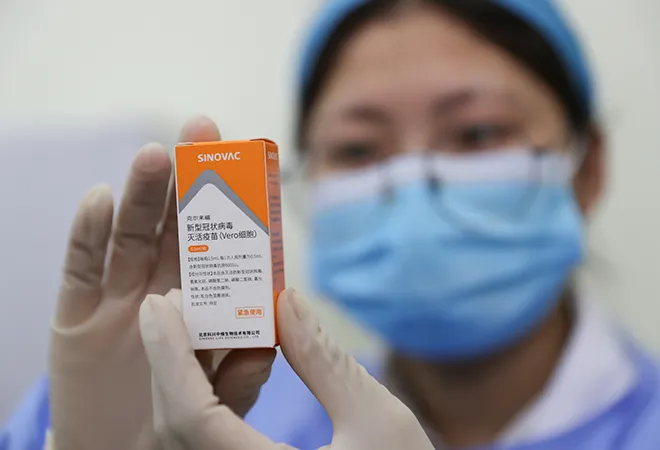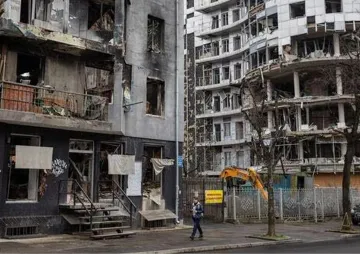
The COVID-19 pandemic has disrupted global health and Medicare industry like no other calamity beforehand. While India’s prowess in science and medicine is centuries old, yet it has taken a while for countries to find the cure for this contagion that struck humanity in 2019. The emerging danger now is that instead of cooperating and uniting to craft a global strategy during such difficult times, countries have begun indulging in vaccine nationalism. Countries not only backed home-made vaccines but the Pharma companies supplied 50 percent of their does to 16 percent of world population. Countries like Britain, France, Germany, and the US have already entered into agreements with the vaccine manufacturers driving race for accessibility and affordability, drawing the criticism of an “America First” (self-first) approach.
The race is just not about who will achieve herd immunity first but also who will make the best of the opportunity to stall global intervention in their domestic spaces. Despite the fact that vaccines are manufactured through long and complex global supply chains, nationalism makes the production networks struggle harder—they had to reinvent their processes and systems and work at a scale never seen before. Keeping aside the logistical success, companies and nations have scuffled over patents and rollout, for instance, the EU is furious that Britain has got a headstart on rollout and acquisition and while India is producing a whopping 1 billion doses of vaccines per year for low-and middle-income countries, Britain has earned an exception and ordered 5 million.
While officially these countries have agreed to WHO’s vision of the vaccine being manufactured for the “shared good”, many of them are indulging in practices that hinder the WHO’s goal of delivering 2 billion doses to poorer and middle-income nations by the end of the year. Many of the countries are incessantly restricting access to materials needed to build more supplies. It is estimated that vaccine nationalism could slow global economic recovery and cost high-income countries US$ 119 billion per year. India has tried to portray itself as a generous benefactor through regional diplomacy, but at the same time, it has sought to control the deployment of doses by a high degree of prioritization. The chief executive of the Serum Institute of India (SII), the world’s largest producer of vaccines, said most of its vaccines “would have to go to our countrymen before it goes abroad”. It rolled out its vaccine program on 16 January through governmental agencies.
However, bottlenecks have arisen from “raw materials nationalism” as noted by the WHO Director-General Tedros Adhanom Ghebreyesus, who lamented America’s invocation of the Defense Production Act to safeguard supplies of items such as bags and filters, for its own manufacturers. The disparity is apparent from the fact that most African nations have received few or no COVID-19 vaccines despite having the most vulnerable populations in their region. By February 2021, Brazil had become the second-most affected country after the US with a heavy death toll putting the country’s overall health into peril.
Most global players aim to tackle growing vaccine nationalism through assistance to the privatized market. The WHO, the Coalition for Epidemic Preparedness Innovations (CEPI), and Gavi have come up with an initiative known as “COVAX Facility” to bring about equitable and broad access and confront the spectre of vaccine nationalism. Along with the CEPI, the COVAX agenda is to provide innovative and equitable access to COVID-19 diagnostics, treatments, and vaccines. So far 170 countries have signed up including UK and China, though India has restrained.
The race for neighbourhood diplomacy
Diplomacy and foreign policy considerations have sought to overpower nationalist tenors. Despite its nationalist rhetoric India has donated most of its home-manufactured vaccines (British-developed AstraZeneca COVID-19 vaccine produced by the SII) to countries like Sri Lanka, Maldives, Bhutan, Nepal, Bangladesh, Myanmar, Mauritius, and Seychelles under its “Vaccine Maitri” initiative. Though the MEA informed that no request for India-made vaccines has been made by Pakistan, rumours of Indian medicines being available in the Pakistani market are abound. India has also supplied many vaccines to both Europe and African countries and even Canada despite having constraints at home.
India has maintained that despite its cooperation efforts at the global level, it will continue to give due importance to its ‘neighbourhood first policy’ while collectively fighting the pandemic. This is in consideration of the precedents set by earlier pandemics like the Swine-flu where the vaccines were developed within seven–eight months and precedents were developed through a centralized, trusted governance system to ensure appropriate flow of capital, information and supplies; for instance, the advance market commitment (AMC) model as well as the International Finance Facility for Immunization which secure funds via bonds.
Meanwhile, China has also supplied its locally developed vaccines to countries like Indonesia, Turkey, and Cambodia, yet there is a preference for Indian manufactured medicines amongst most Southeast and South Asian countries. This is a proud moment for the Indian industry as the Indian brands, some manufactured with foreign assistance like the AstraZeneca/Covishield which has British interest attached and others like the Indian made Covaxin developed by Bharat Biotech in collaboration with the Indian Council of Medical Research (ICMR) continue to evoke feelings of trust, quality, and high-ranging deliverance bolstering a positive form of proud nationalism amongst the countrymen. The comparative advantage against China in this field is a much welcome respite since in the neighbourhood attention-grab amongst these two Asian giants, China usually overshadows India in military and economic might.
Nationalism has, however, played out very differently at home for China. While on the one hand it has meant that China wanted to project its vaccines as effective and more suited for use in and around its immediate neighbours, on the other hand it has increased restrictions on those wanting to do business with China. Beijing has unveiled a new visa policy which applies to foreigners entering the mainland from Hong Kong. Intake of a China-made vaccine removes all hassles and makes paperwork easy and one does not even have to take a COVID-19 test or fill out a travel declaration form. Instead of fostering collaboration on the pandemic data, China is reducing choice of freedom for individuals and creating its own ‘Red supply Chain’. President Xi Jinping even announced that the medication would be a part of its ‘Health Silk Road’.
The two Asian giants have been indulging in donating or exporting medical supplies in an effort to burnish their soft power, gain firm footholds in new markets and also invoke domestic nationalism by telling their respective audiences that they are major influencers at the world stage. Recently, Foreign Minister S. Jaishankar declared that the country’s “Vaccine Friendship” program has “raised India’s standing and generated great international goodwill.” Against this backdrop of rising nationalism, the Modi government has portrayed its vaccine effort as part of a successful quest to create a “self-reliant India.”
So far, India has managed to vaccinate 40 million people. Though Beijing is reportedly said to have done a better job in controlling and disbursing vaccines to its citizens, it can be attributed to the fact that the virus originated there and they had a head on advantage dealing and restricting the spread. The three Chinese firms—Sinopharm, Sinovac, and CanSino have received orders for roughly 572 million doses and promised another 10 million to COVAX. The Chinese Foreign Ministry says it plans to provide free vaccines to 69 countries and sell them to another 28 countries. On the other hand, India’s response has been measured and slow, it has received limited information from the Chinese sources and had to deal with the virus mainly through lockdown and restrictive procedures.
Nevertheless, India has tied with other nations like the Quad partners, who at their first virtual summit pledged to supply at least one billion doses of vaccines, including one developed by Johnson & Johnson, to Indo-Pacific nations by the end of next year. Under this arrangement US, Japan, and Australia will fund the production of the vaccine by Indian firm, Biological E. This comes as a direct response to China’s efforts to compete through vaccine diplomacy.
The global economy has been affected to the amount of US$ 375 billion every month, with potential lethal consequences which could be prevented by avoiding vaccine nationalism. The paradox of nationalism in our times is such that we can’t possibly live with it and we can’t possibly live without it. The antidote lies in vaccine multilateralism through an international collaborative effort in the direction of achieving wellness and health for all under the aegis of the UN-subscribed sustainable development goals. It would be, thus, in both India and China’s benefit to stop competing and start engaging with global players and contribute to global welfare instead of competing for narrow interests in the neighbourhood. These are indeed interesting times, and both these Asian giants have the opportunity to regain their traditional splendor and recognition in the field of medicine and prove their mettle in comparison to the West. It lies with them now to help their neighbours as well as their own citizens fight this epidemic and not revel in the narrow constraints of domestic nationalism.
The views expressed above belong to the author(s). ORF research and analyses now available on Telegram! Click here to access our curated content — blogs, longforms and interviews.




 PREV
PREV


